Archbishop Marcel Lefebvre: 'The visibility of the Church and the current situation'
At a priests' retreat, a few months after the 1988 episcopal consecrations, Archbishop Marcel Lefebvre made important comments which might alarm some today.
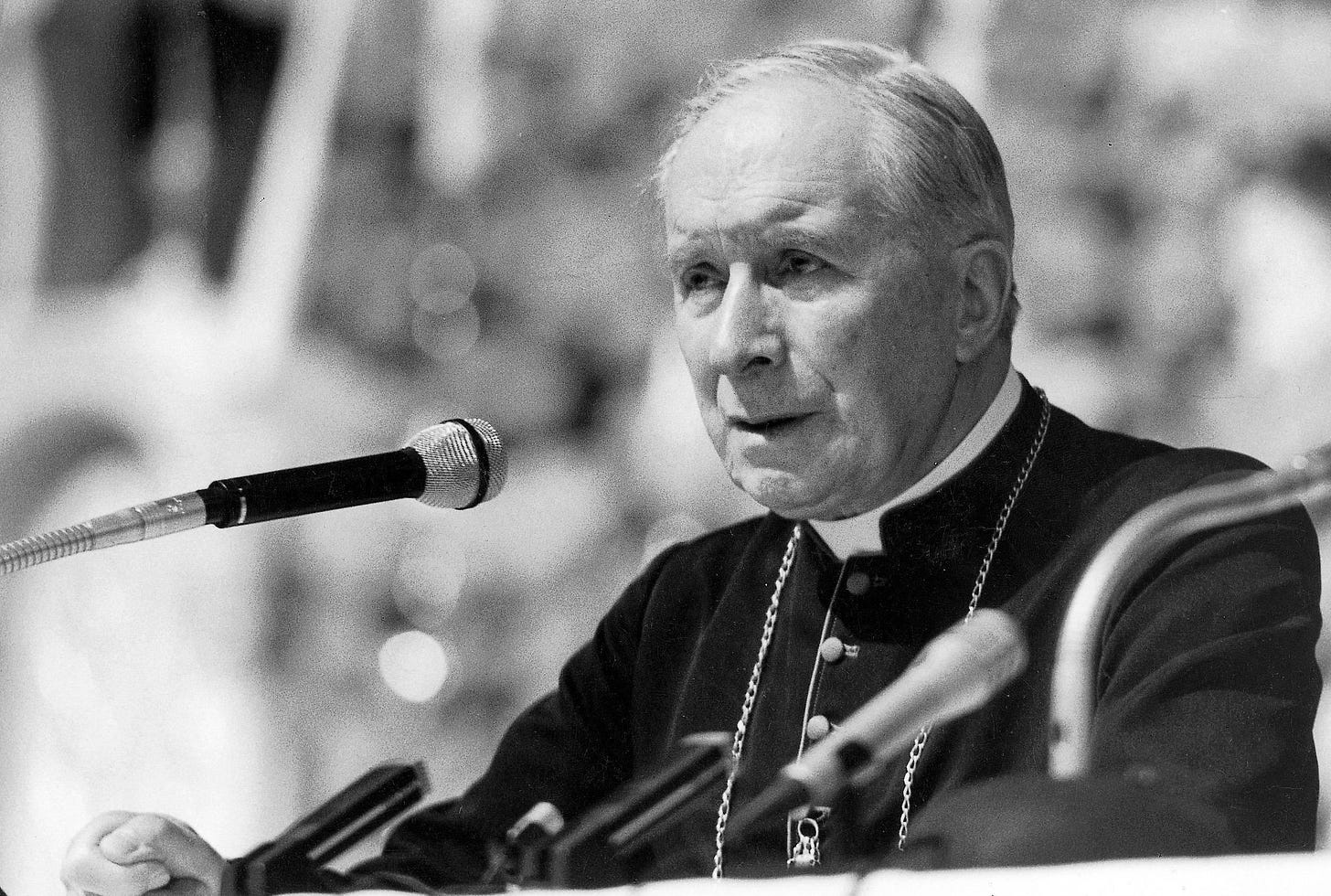
At a priests’ retreat, a few months after the 1988 episcopal consecrations, Archbishop Marcel Lefebvre made important comments which might alarm some today.
Editors’ Notes
The following text is from a conference delivered by Archbishop Marcel Lefebvre at a priests’ retreat in 1988.
We have previously referred to this conference elsewhere, but to our knowledge, it has not been published in full in English before.
As with another which we published recently, it reveals the state of Lefebvre’s mind after the defining moment of his life – the consecration of the four bishops without the mandate of John Paul II.
As such, regardless of whether one agrees with it or not, it is an important text for the historical record.
Some highlights
“You continue, and you really represent, the Church: the Catholic Church. I think you need to be convinced of this: you really represent the Catholic Church. Not that there is no Church outside of us; that is not the point. But lately we have been told that it is necessary for Tradition to enter the visible Church. I think that this is a very, very serious mistake.
“Where is the visible Church? The visible Church is recognised by the signs she has always given for her visibility: she is one, holy, catholic and apostolic.
“I ask you: where are the true marks of the Church? Are they more in the official Church (it is not the visible Church, it is the official Church) or in us, in what we represent, what we are?”
“To leave, then, the official Church? In a certain measure, yes, obviously. The entire book of Mr. Madiran, The Heresy of the Twentieth Century, is the history of the heresy of the bishops. One must therefore leave that milieu of the bishops, if one wishes not to lose one’s soul.
“But that is not enough, for it is at Rome that the heresy is established. If the bishops are heretics (even without taking this term in its full canonical sense and consequences), it is not without the influence of Rome.
“If we keep our distance from such people, it is exactly as with persons who have AIDS: one has no desire to catch it. Now they have spiritual AIDS – contagious diseases. If one wishes to preserve one’s health, one must not associate with them.”
Some comments
Lefebvre's use of the term “official Church” is somewhat regrettable. It is clear what he meant to say: the organisation based in the Vatican, with John Paul II at its head then, and Leo now, is not the Catholic Church or equivalent to the Catholic Church. Nonetheless, his language is liable to be misunderstood as suggesting a disconnect between the official hierarchical Church and the Mystical Body of Christ, whereas they are identical. It is no doubt a difficult situation to describe precisely: we have explored what he is saying elsewhere. The fact remains that the disconnect mentioned is only possible because the men who purport to be the hierarchy are, overwhelmingly, illegitimate usurpers – and the body which they rule, taken as a whole, is not the Catholic Church.
While Lefebvre’s treatment of the four marks is powerful and instructive, some aspects are wanting: as with many Catholics after Vatican II, he under-appreciates the importance of apostolicity of government – speaking as if it can be compensated by apostolicity of doctrine. This is not the case, as we have discussed elsewhere.
Naturally, we do not accept the idea that a legitimate Roman Pontiff could be accused of what Lefebvre suggests, nor that it is proper to attribute to “Rome” what Lefebvre attributes at other times to the “Conciliar Church” – sometimes making a distinction, and other times not. We also note that his passing reference to “sedevacantists” requires some context, which we have endeavoured to provide in a footnote. We have explained elsewhere our rationale for publishing such texts, even when they contain such points.
You can read the original French here and below:
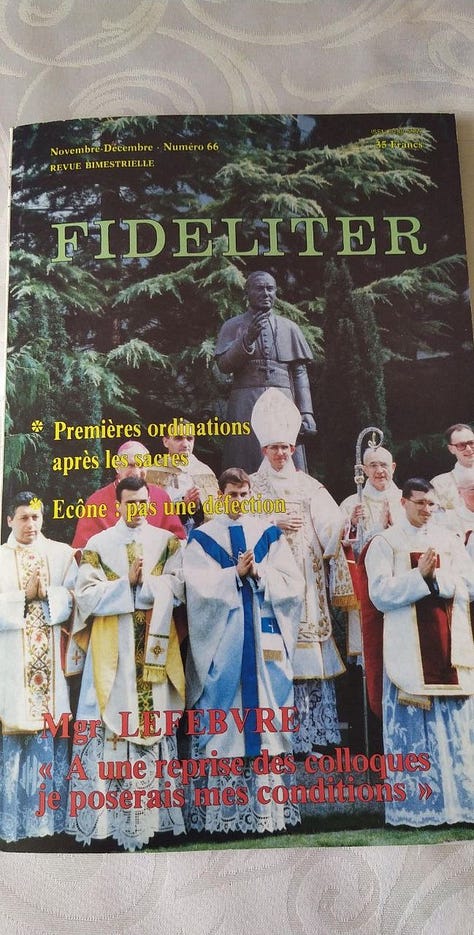
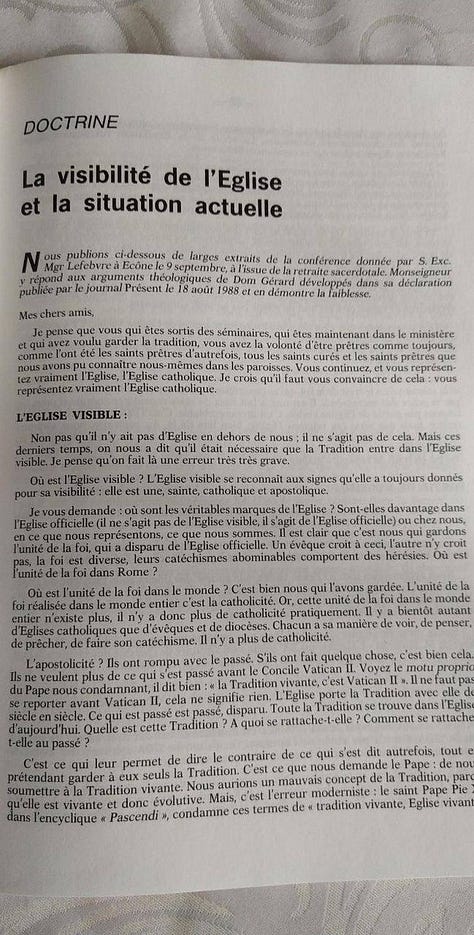
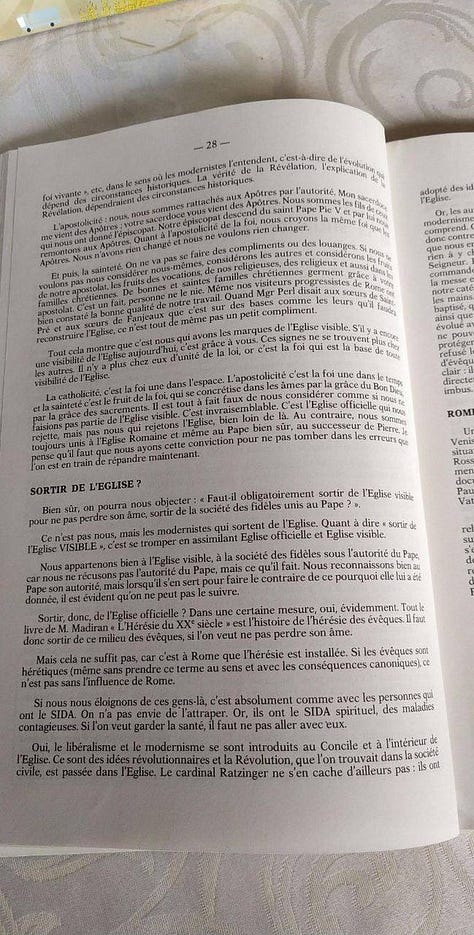
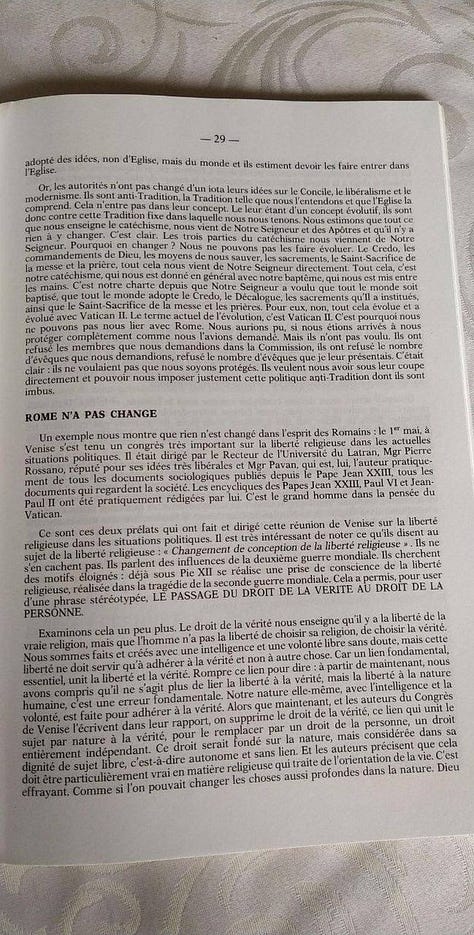
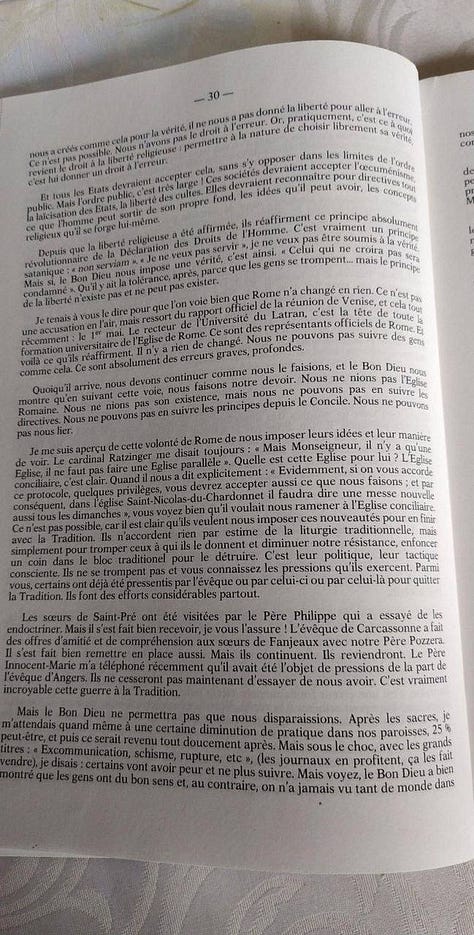
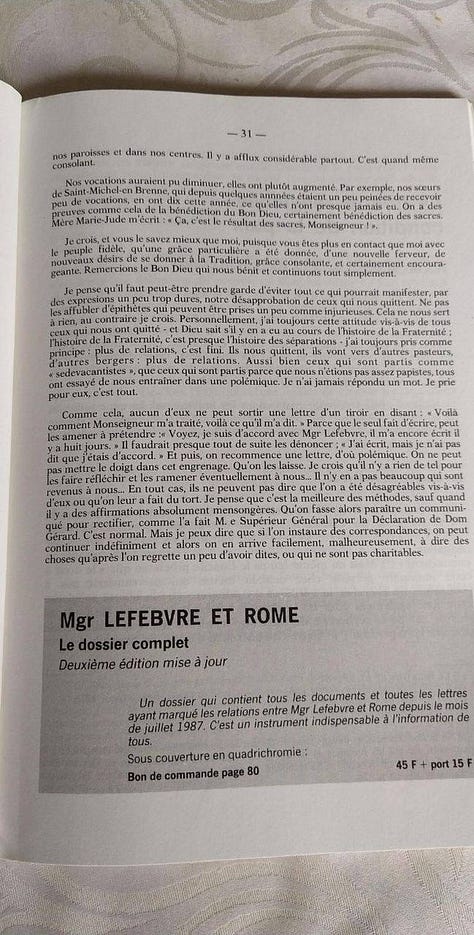
The visibility of the Church and the current situation
Archbishop Marcel Lefebvre
Conference at a priests’ retreat at Ecône, 1988
Originally published in Fideliter n. 87, Nov-Dec, 1988.
We publish below large extracts from the conference given by His Excellency Archbishop Lefebvre at Ecône on 9 September, at the conclusion of the priests’ retreat. In it, the Archbishop responds to the theological arguments of Dom Gérard, developed in his declaration published by the newspaper Présent on 18 August 1988, and demonstrates their weakness.
My dear friends,
I think that you, who have come out of the seminaries, who are now engaged in the ministry, and who have wished to preserve tradition, have the will to be priests as they always were – like the holy priests of former times, all the holy curés and holy priests whom we ourselves have been able to know in the parishes.
You continue, and you really represent, the Church: the Catholic Church. I think you need to be convinced of this: you really represent the Catholic Church.
The visible Church
Not that there is no Church outside of us; that is not the point. But lately we have been told that it is necessary for Tradition to enter the visible Church. I think that this is a very, very serious mistake.
Where is the visible Church? The visible Church is recognised by the signs she has always given for her visibility: she is one, holy, catholic and apostolic.
I ask you: where are the true marks of the Church? Are they more in the official Church (it is not the visible Church, it is the official Church) or in us, in what we represent, what we are?
It is clear that it is we who keep the unity of the faith, which has disappeared from the official Church. One bishop believes in this, the other does not; the faith is diverse, their abominable catechisms contain heresies. Where is the unity of faith in Rome?
Where is the unity of faith in the world? It is we who have kept it. The unity of faith realised in the whole world is catholicity. Now, this unity of faith in the whole world no longer exists, so there is no longer any catholicity in practice. There are soon as many Catholic Churches as there are bishops and dioceses. Each one has its own way of seeing, of thinking, of preaching, of doing its catechism. There is no longer any catholicity.
Apostolicity? They have broken with the past. If they have done anything, it is this. They no longer want what happened before the Second Vatican Council. Look at the motu proprio of the Pope condemning us, he says: “The living Tradition is Vatican II”. We must not go back to before Vatican II, it does not mean anything. The Church carries Tradition with her from century to century. What is past is past, gone. All Tradition finds itself in the Church of today. What is this Tradition? To what is it linked? How does it relate to the past?
This is what allows them to say the opposite of what was said in the past, while claiming to keep the Tradition to themselves. This is what the Pope asks of us: to submit to the living Tradition. We would have a bad concept of Tradition, because it is living and therefore evolving. But this is the modernist error: Pope Pius X, in his encyclical Pascendi, condemns these terms “living tradition, living Church, living faith”, etc., in the sense in which the modernists understand it; that is, evolution that depends on historical circumstances. The truth of Revelation, the explanation of Revelation, would depend on historical circumstances.
Apostolicity: we, we are linked to the Apostles by authority. My priesthood comes to me from the Apostles; your priesthood comes to you from the Apostles. We are the sons of those who gave us the episcopate. Our episcopate comes from the holy Pope Pius V and through him we go back to the Apostles. As for the apostolicity of the faith, we believe the same faith as the Apostles. We have not changed anything and we do not want to change anything.
And then, holiness. We are not going to flatter or praise ourselves. But if we don’t want to consider ourselves, let’s consider others and let’s consider the fruits of our apostolate, the fruits of vocations, of our religious and also in Christian families. Good and holy Christian families are sprouting thanks to your apostolate. It is a fact, no one denies it. Even our progressive visitors from Rome have noted the good quality of our work. When Bishop Perl said to the Sisters of Saint-Pré and Fanjeaux that it is on bases like theirs that the Church must be rebuilt, this is no small compliment.
All this shows that it is we who bear the marks of the visible Church. If there is still any visibility of the Church today, it is thanks to you. These signs are no longer to be found among the others. The unity of faith no longer exists with them, yet it is faith which is the foundation of all visibility of the Church.
Catholicity is faith one in space; apostolicity is faith one in time; and holiness is the fruit of faith, made concrete in souls by the grace of the good God, by the grace of the sacraments.
It is entirely false to consider us as if we did not form part of the visible Church. That is inconceivable. It is the official Church that rejects us, not we who reject the Church – far from it. On the contrary, we are always united to the Roman Church, and even to the Pope, of course, to the successor of Peter. I think that we must hold this conviction in order not to fall into the errors now being spread.
To leave the Church?
Of course, some may object: “Must one necessarily leave the visible Church in order not to lose one’s soul – leave the society of the faithful united to the pope?”
It is not we, but the modernists, who depart from the Church. As for saying “to leave the visible Church,” that is a mistake, for it confuses the official Church with the visible Church.
We belong indeed to the visible Church, to the society of the faithful under the authority of the Pope, for we do not reject the authority of the Pope, but what he does. We fully acknowledge the Pope’s authority; but when he uses it to do the opposite of what it was given to him for, it is evident that we cannot follow him.
To leave, then, the official Church? In a certain measure, yes, obviously. The entire book of Mr. Madiran, The Heresy of the Twentieth Century, is the history of the heresy of the bishops. One must therefore leave that milieu of the bishops, if one wishes not to lose one’s soul.
But that is not enough, for it is at Rome that the heresy is established. If the bishops are heretics (even without taking this term in its full canonical sense and consequences), it is not without the influence of Rome.
If we keep our distance from such people, it is exactly as with persons who have AIDS: one has no desire to catch it. Now they have spiritual AIDS – contagious diseases. If one wishes to preserve one’s health, one must not associate with them.
Yes, liberalism and modernism have entered the Council and the interior of the Church. These are revolutionary ideas, and the Revolution, which once existed in civil society, has passed into the Church. Cardinal Ratzinger does not conceal it: they have adopted ideas not of the Church, but of the world, and they think they must introduce them into our Church.
Now, the authorities have not changed one iota of their ideas on the Council, on liberalism, or on modernism. They are anti-Tradition – Tradition as we understand it and as the Church understands it. That does not fit into their concept. Theirs is an evolutionary concept; they are therefore opposed to that fixed Tradition in which we stand. We hold that everything the catechism teaches us comes from our Lord and from the Apostles, and that nothing in it is to be changed. It is clear. The three parts of the catechism come to us from our Lord. Why change them? We cannot make them evolve. The Creed, the Commandments of God, the Means of Salvation (the sacraments, the holy sacrifice of the Mass, and prayer) – all these come to us directly from our Lord. All this is our catechism, given to us generally with our baptism, placed into our hands. It is our charter, ever since our Lord willed that all should be baptised, that all should adopt the Creed, the Decalogue, the Sacraments which he instituted, as well as the holy sacrifice of the Mass and the prayers.
For them, no: all this evolves and has evolved with Vatican II. The present term of this evolution is Vatican II. That is why we cannot bind ourselves to Rome. We might have done so if we had been able to obtain complete protection, as we had requested. But they did not wish it. They refused the members we asked for on the Commission; they refused the number of bishops we requested; they refused the candidates I proposed to them. It was clear: they did not want us to be protected. They wish to have us directly under their control and to be able to impose upon us that anti-Tradition policy with which they are imbued.
Rome has not changed
An example shows us that nothing has changed in the spirit of the Romans: on 1 May, in Venice, a very important congress was held on religious liberty in present political situations. It was directed by the Rector of the Lateran University, Monsignor Pietro Rossano, known for his very liberal ideas, and by Monsignor Pavan, who is, in practice, the author of all the sociological documents published since Pope John XXIII – all the documents relating to society. The encyclicals of Popes John XXIII, Paul VI, and John Paul II were practically written by him. He is the leading mind in Vatican thought.
It was these two prelates who organised and directed this meeting in Venice on religious liberty in political situations. It is most interesting to note what they say about religious liberty: “A change in the conception of religious liberty.” They do not conceal it. They speak of the influences of the Second World War. They seek remote causes: already under Pius XII, they say, there arose an awareness of religious liberty, born of the tragedy of the Second World War. This permitted, to use a stock phrase, the passage from the right of truth to the right of the person.
Let us examine this a little further. The right of truth teaches us that there is liberty for the true religion, but that man does not have the liberty to choose his religion, to choose the truth.
Without doubt, we are made and created with intelligence and free will; but this liberty must serve only to adhere to the truth, and not to anything else. For a fundamental and essential bond unites liberty and truth. To break this bond and to say, “From now on we have understood that it is no longer a question of linking liberty to truth, but of linking liberty to human nature” – this is a fundamental error. Our very nature, with intelligence and will, is made to adhere to the truth. Yet now, as the authors of the Venice Congress write in their report, they suppress the right of truth, that bond which by nature unites the subject to truth, and replace it with a right of the person – a wholly independent right. This right would be founded on nature, but considered in its dignity as a free subject, that is, autonomous and without bonds. And the authors specify that this must be particularly true in religious matters, which concern the orientation of life. It is terrifying. As if one could alter such deep things in nature.
Let us simply continue
God blesses our parishes and our centres. There is a remarkable influx everywhere. It is quite extraordinary.
Our vocations might have diminished; instead, they have rather increased. For example, our sisters of Saint-Michel-en-Brenne, who for some years were somewhat saddened by receiving few vocations, have ten this year – something they have hardly ever had. We have such proofs of the blessing of the good God, certainly a blessing of the consecrations. Mother Marie Jude writes to me: “That is the result of the consecrations, Monseigneur!”
I believe, and you know it better than I do, since you are more in contact than I with the faithful people, that there is a grace of new fervour, of new desires to devote oneself to Tradition – a consoling and certainly encouraging grace. Let us thank the good God who blesses us, and let us simply continue.
I think we must perhaps take care to avoid anything that might express, through words too harsh, our disapproval of those who leave us. Let us not attach to them epithets that might be taken as injurious. It serves us no purpose; on the contrary, I believe. Personally, I have always kept this attitude towards all those who have left us – and God knows there have been many in the history of the Society; the history of the Society is almost a history of separations – I have always taken as a principle: no more relations, it is finished. They leave us, they go to other pastors, other shepherds – no more relations. Whether those who left as “sedevacantists,”1 or those who left because we were not papalist enough, all have tried to draw us into polemics. I have never replied a word. I pray for them, that is all.
In this way, none of them can take a letter out of a drawer saying: “Here is how Monseigneur treated me, here is what he said to me.” For the mere fact of writing might lead them to claim: “See, I am in agreement with Archbishop Lefebvre; he wrote to me again eight days ago.” One would almost have to denounce them immediately: “I wrote, but I did not say I agreed.” And then one begins another letter, whence polemics. One cannot put one’s finger in that machinery. One must leave them. I think there is nothing better to make them reflect and perhaps bring them back to us... Not many have come back to us…
In any case, they cannot say that we have been disagreeable towards them or have done them harm. I think that is the best method, except when there are absolutely false assertions. Then one should issue a communiqué to correct them, as the Superior General did regarding Dom Gérard’s Declaration. That is normal. But I can say that if one begins a correspondence, it can go on indefinitely; and unfortunately, one easily comes to say things that, afterwards, one regrets a little having said, or that are not charitable.
HELP KEEP THE WM REVIEW ONLINE WITH WM+!
As we expand The WM Review we would like to keep providing free articles for everyone.
Our work takes a lot of time and effort to produce. If you have benefitted from it please do consider supporting us financially.
A subscription gets you access to our exclusive WM+ material, and helps ensure that we can keep writing and sharing free material for all.
You can see what readers are saying over at our Testimonials page.
And you can visit The WM Review Shop for our ‘Lovely Mugs’ and more.
(We make our WM+ material freely available to clergy, priests and seminarians upon request. Please subscribe and reply to the email if this applies to you.)
Subscribe to WM+ now to make sure you always receive our material. Thank you!
Read Next:
Follow on Twitter, YouTube and Telegram:
Cf. John Lane:
“The facts remain, however, that Archbishop Lefebvre only ever expelled from the Society two priests for public sedevacantism, and never any priest for private sedevacantism. This may surprise some who have a different impression, but those are the facts.
“When we review the various texts in which Archbishop Lefebvre appeared not only to reject the sedevacantist solution himself, but to condemn it, we find that in each case he was reacting to the pressure of circumstances, and almost in every case he was referring to concrete cases of sedevacantist individuals rather than to the theoretical question itself. Thus when he stated that sedevacantism is ‘schismatic’ he clearly meant that the mentality of the specific sedevacantists he was then addressing or reacting to had a schismatic mentality – that is, they valued their opinions more than the unity of the faithful. And this interpretation is confirmed by consideration of the various statements made by Archbishop Lefebvre over the years – those presented above as well as of those which will follow below. If he really thought that the notion that Paul VI or John Paul II was not a true pope was essentially schismatic, then how could he possibly have honestly permitted many of his seminarians and priests to hold it, and a fortiori to consider adopting it himself?”
Archbishop Lefebvre and The Sedevacantist Thesis
See also:

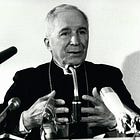
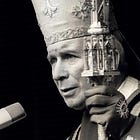
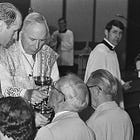
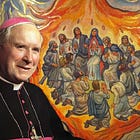

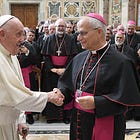
Hey All- some so called trad influencers have just launched a new app called Pelican Plus — all things traditional Catholic except for sedevacantists. Does anyone know how to build an app like that or know someone who can? There’s certainly enough content on YouTube and here to fill an app with.
I agree the past has been broken with, perhaps broken is not the right but Rome has consciously rejected its own Apostolic Succession which we can see visibly in its scramble to Synodality, it is surrendering the authority that comes with being Apostolic because it no longer wishes to be Apostolic.